
3 Formative Works: Akira
August 7th, 2010 by david brothers | Tags: 4321, akira, katsuhiro otomo, kodansha, manga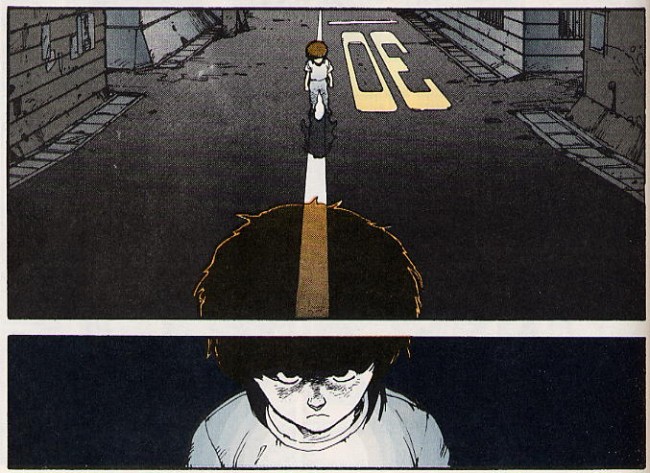
I don’t know if I could separate the film and comic versions of Katsuhiro Otomo’s Akira in my head if I tried. They’re both vastly important, but for different (and sometimes complementary) reasons. Akira was one of the first anime flicks I ever watched, and it made an indelible impression on me. I still have never seen Blade Runner, but I probably feel about Akira like other people do about Blade Runner. I had a tape I dubbed from the video store, the official cassette, the special edition DVD (with the tin), and now I own the Blu-ray, except the dub is different, so I went ahead and bootlegged a 1080p video file with the old school dub, too. I like this movie, man.
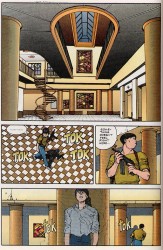
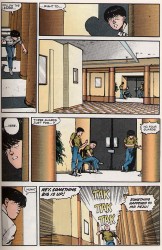
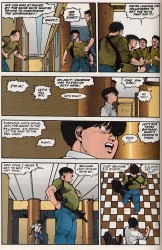
I came to the comic later, and like everything I read back then, I read it in fits and spurts. I read maybe four whole issues when I was a kid, all of them set before the big disaster struck Tokyo. They’re long gone now, but they were pretty stunning. They definitely stood alongside Sin City as being comics that were vastly better than the other comics I owned, even if I was too young to articulate why. It was a little more grown-up, a little more edgy, and Steve Oliff’s colors were amazing. I don’t think I even really knew what manga was at this point–I’d heard about Japanese comics, and my comics-reading uncle had lived in Japan so I was up on some stuff, but I didn’t really know about manga as something different from regular comics. I just knew that Akira was something special, different from the movie and possibly better.
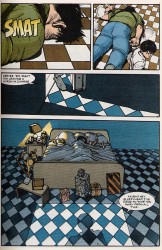
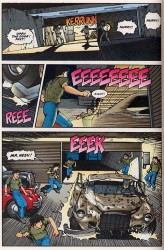
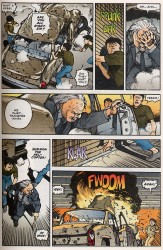
In the late ’90s, I picked up two of the hardcovers that Graphitti Designs put out. The covers are almost identical to the Dark Horse versions. The local comic shop guy was your typical comic shop douchebag, unkempt and rude, and he let the two HCs, which were limited editions and behind the glass, go for fifteen each. Today, they’re worth ten times that. I ended up with books 2 and 4, set before and after everything goes wrong. They did little to show me exactly what the series was about, because I had two sets of 400 non-consecutive pages out of a series that ran over 2000 pages, but it did just increase my fascination with the series as a whole.
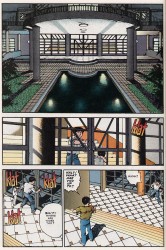
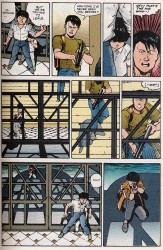
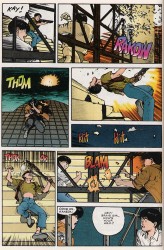
Everything was interesting. The draftsmanship, the way Tetsuo swallowed pills, the insane sex scene, the flashbacks, the ruined city… it really hit me in a way most sci-fi doesn’t. I’ve only ever had two holy grails in comics, books that I absolutely had to have at any (reasonable) price. Flex Mentallo was one, but I didn’t know that existed until what, 2005? When I got grown and could afford to buy whatever comics I wanted, Akira was the first and most important holy grail there was.
Finding more of the old Graphitti HCs proved to be almost impossible. Websites that listed them didn’t respond to emails, eBay was a joke, and you’d think that these books never existed. In 2004, Barnes & Noble issued a hardcover version of the Dark Horse volume 1, and I picked that up. It sucked that it was in black & white, but hey: 1) hardcover and 2) I had to have it. I held out hope that I would find the Graphitti versions for the rest, but eventually gave up and started buying the Dark Horse editions… right after they went mostly out of print. That’s no big deal now that Kodansha is rereleasing the series, but a few years ago, it was massively frustrating.
Finding and reading Akira in its entirety has been a quest some fifteen years in the making. I only picked up the sixth and final volume in early ’08, and that was after some serious searching. I can’t think of another series I’ve pursued off and on for that long. Scooping up the complete Sin City was easy, except for finding a copy of the old school Family Values printing. Flex Mentallo took a few eBay auctions. Akira took effort, for one reason or another.
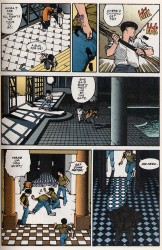
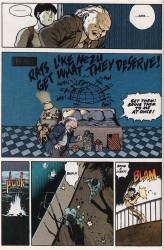
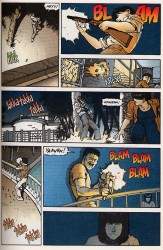
It was worth the effort, though. Akira is one of my top three favorite books, and a pitch perfect example of how to do a sprawling, huge story without screwing it all up in the end. The art is off the charts, with consistently great layouts and inventive storytelling. It’s probably akin to Cerebus, except if Cerebus was great from the beginning and if Dave Sim didn’t go insane around the middle. It works, and at some 2000 pages, it really shouldn’t work. It should be bloated and ugly and drag, but it doesn’t.
What’s interesting about the English adaptation of Akira is that it goes against conventional manga translating wisdom in a few ways. It’s both flipped and in color, already a tremendous departure from the original work. Jo Duffy’s translation was meant to be appealing to American audiences first, which allowed her a certain degree of freedom in playing with the dialogue. All of this was done with the permission and approval of Otomo and Kodansha, of course, but if you had to make a list of changes to books that manga fans don’t like, it’d probably go 1) flipped, 2) color, and 3) localization. Not to mention its trim size (or more accurately, trim sizes across the various formats) and the fact that it was a computer-colored, story-driven manga released in the early ’90s, when garishly colored, art-driven superhero comics ruled the roost. Akira, in America, shouldn’t be what it is, and yet… here we are.
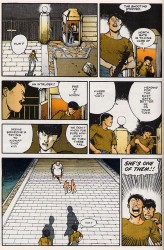
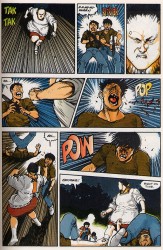
(An aside: I was at New People in Japantown when I saw a familiar logo on an unfamiliar spine. It turns out that Kodansha took Marvel/Epic’s Akira volumes, reflopped them, relettered them in Japanese, and re-released them in Japan in some very nice slipcased volumes. Every time I go in that building I am tempted to buy them. They have three or four, I think. I’m far from an expert in Japanese editions, but I’ve never heard of companies doing that before. You can see the covers here, along with some incorrect data [it’s definitely the Epic colorization]. Covers are ill, though, right? Someone talk me out of buying them.)
I haven’t talked at all about what Akira is about, have I? It doesn’t really matter. I could do that at any time, about any scene. The images in this post are from issue fourteen of the Epic run, one of the ones I distinctly remember poring over as a kid. The only thing the pages I’ve excerpted are missing is the crazy ill way Otomo would draw moving headlights, something that made it into the film and imprinted onto my mind as something awesome as a young age. (It only happens twice in this chapter, on Nezu’s front and rear lights.) But look at that atrium on akira-01.jpg, the body language on akira-02.jpg, the comedy on akira-03.jpg, the car on akira-05.jpg, the ridiculous camera shifts in akira-08.jpg (panels 7-9 make me swoon), Kay’s pose in panel three in akira-09.jpg, or the way Otomo keeps showing the windup and the effect, but not the impact, or–
pause
Akira is a triumph, one of those comics I try to reread at least once a year and fall in love with a little more each time. It’s over twenty years old, and while it has definitely aged some, it still beats the pants off a lot of things we consider quality nowadays.
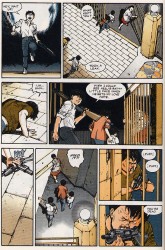
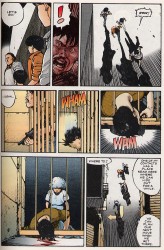
And it has the best last page in comics, hands down.
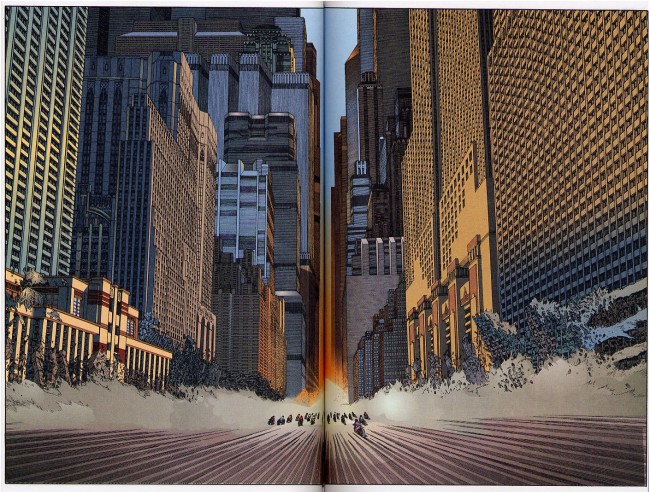

I’ve never gotten around to reading Akira, and while I’ve seen the movie and it was pretty awesome, it was only the edited for TV version they used to show pretty regularly on the Sci-Fi channel in the ’90s. So, I don’t feel qualified to discuss too much about the series. That said, there is one thing I’ll disagree with. As a manga released in the US in the ’80s, I’d only be surprised if it weren’t colored and flopped.
It may be unthinkable now that people know what manga is and can buy collected volumes en mass at book stores, but back then no one expected there to be a market for it so they tried to sneak it in with the other comics at the comic shop. I don’t really know this first hand, but I understand that Viz colored their early releases, even though they were specializing in manga. Even after they stopped, the order of the day were 32-page floppies, flopped and sold at comic stores for most of the ’90s. Getting unflopped collected volumes into book stores is probably the only thing I’d ever give TokyoPOP credit for.
@Gaijin D: That’s what I’m saying–conventional wisdom suggests that following the TOKYOPOP format is what leads to successful manga, and pretty much everything that was released back then flopped has been rereleased in the now standard manga format, with Lone Wolf & Cub being a notable exception. Akira goes against the grain in that sense.
Akira will probably be the first series I ever re-buy trades for, because I have no idea where the fuck my Dark Horse volumes went… and even then I was apparently buying them while it was out of print, which is why I never found it past volume two. I actually skipped the panels in this post because I don’t want to risk spoiling shit for myself. (Nice going on not being detail-specific in these, by the way.)
I saw the first three in new printings today at the store. It took a very patient friend to walk me away from $75 worth of manga because I was very, very close to buying them all.
That last page is awsome!
I read Akira when I was a teen, but it doesn’t “rush” me now, and the portuguese lay-out of Akira series was made in “mirror mode”, just to fit with the normal way of readind, and that becames strange for me now, because I read a lot of Manga now in the japanese way of reading. I think the first american series of Akira was published in “mirror mode” too…
I prefer Akira in black & white, in the regular manga way of reading (left to right).
😉
This is painful to read for me. A few years ago – before I got seriously into collecting comic books – I walked into a used book store and found a complete set of Akira in a French translation, black-and-white softcover edition. (French is my native language, so just as good as an English translation for me.) I don’t remember how much I paid for it, but I remember thinking it was an amazing deal.
I read about half of it, but didn’t get through the whole thing. I was only taking a break and had every intention to finish reading it eventually. Then a co-worker of mine expressed an interest in it, so I started lending the volumes to her, one by one. She made it all the way to volume 4, which she never gave back to me. Then she moved to India. She came back from India a year later and I asked if she still had that book. She insists that she returned it to me, but I know she didn’t.
So now I have volumes 1-3, 5-6 on my shelf. Volume 4 is missing, gone forever, and I’ll probably never find a replacement for it in that same out-of-print edition. Every time I see the books on my shelf, I die a little.
PS: Actually, writing the above prompted me to do some research online and I think my edition might not be as hard to find as I originally thought. I might see if I can order a copy from a local bookstore. It’s about time I replace the missing volume and read the whole thing.
GREAT writeup, David. The movie I found powerfully affecting, but the manga is just amazing. I know Otomo had assistants and everything, but there’s a tremendous amount of effort put into every single panel of this series that beggars the imagination.
I felt more detached from the manga (which I read when Dark Horse did the 2000 reprints) than I did from the movie (which I first watched on video in 1993), but I was very different then, and in some ways, the same.
I actually checked after reading this to see where my Dark Horse volumes were, and they were right where I left ’em. Whew. 😉
@david brothers: Hm. Well, looking online, it seems the current edition is a reprint of a Dark Horse edition from around 2001. It’s flopped, but doesn’t seem to use any color pages aside from those done by Otomo himself, which were probably for the original Japanese serialization. I think I see your point in that if it were a new edition, it would be unflopped. Dark Horse, as I recall, held on to left-to-right longer than most, probably because while they have several significant manga releases they’re still primarily a comics publisher. A flopped Akira release in 2001 doesn’t surprise me. Even dedicated manga publishers like Viz continued flopping existing series, saving unflopped editions for new series. For instance, even after moving to the smaller format, Ranma 1/2 remained flopped. To my knowledge, there’s never been a right-to-left edition, even though it was Viz’s first big hit.
@ Gaijin D : That might be more of an issue with licensing than an unwillingness or whatever to change formats. If Viz wanted to re-release Ranma 1/2 in unflopped tpb’s, they would probably have to renegotiate their licensing rights. Or so I’ve heard.
@david brothers: It’s not just the flipping, you need to give props to Akira’s translation job, which made an effort to make the dialog work as speech rather than simply directly translating the original text, added to which the speech across multiple balloons in the same panel was in the correct reading order, which is something that unflipped manga doesn’t manage to get right even today.
You’re also giving a little too much credit in citing the Tokyopop method as a deliberate ‘formula’ rather than the end result of creating the cheapest possible product.
The excellent review has me hovering over the “buy” button on Amazon for the first volume. From what I can tell these new editions are the only way to read it without paying up the ass. They won’t all be released for another year though! Just have to decide whether to read the first volumes now or wait until it’s all out in 2011.
@Drew: I’d go for the first three right now and get the rest later or in the Dark Horse editions, honestly. Kodansha has been quieter than I’d like in terms of releasing new books. You can probably find some of the Dark Horse editions in bookstores or comic shops, if you’re lucky.
lol ,your story of searching for the complete Akira is very similar to mine I found the first volumes then some others with a clear gap which increased the frustation and after years of searching I finally could read the entire story.
A manga worth the search.
Akira doesn’t sound right to me unless it’s the original, old school dub for me too, lol. Someday, I’ll get around to ripping the audio track and sync it up with my Blu-ray when I watch it. It tows the line between faithful dubbing and cheesy old school kung-fu dubbing.
I haven’t read the colored version does it add anything? Black and White was phenomenal. Otomo is one of the all time king of Comic art.
Also the Film is my favorite animated feature. It is one of the defining moments of animation.
http://www.youtube.com/watch?v=BBAJdtPVnZc
No other film has ever looked like Akira, before or since. It’s stunningly fluid and detailed animation often required as many as nine separate cel layers. The 125 minute feature was comprised of over 160,000 cels and almost as many backgrounds, each one completely hand–drawn and hand-painted. Purists recognize Akira as the last completely hand-created animated feature, as cel animation quickly gave way to cheaper digital production and CGI technology.
They had to combine 13 different animation houses to have enough staff to put all that together.
Have you read Domo David?
@JTabon: That does make sense, though the issue is muddied by the fact that there are series that switched mid-stream and had earlier volumes re-released in right-to-left. Perhaps a better example, which occurred to me later, is Vertical. They still release flopped books today, and they’ve got some big time licenses like several Osamu Tezuka works.
@Al Loggins: The cheapness of their product is a big part of why I only grudgingly credit them with opening up the bookstore market. Combined with some of the things the company’s tried to pull over the years, going all the way back to their beginning as Mixx Publications, I find them incredibly untrustworthy. It bothers me that they’ve managed to license so many good titles over the years, as otherwise I’d easily be able to avoid buying any of their releases.